
MANUFACTURER'S SPECIFICATIONS
Frequency Response: 30 Hz to 14 kHz, 30 Hz to 16 kHz with FeCr and CrO2 tapes.
S/N Ratio: 59 dB, 69 dB with Dolby NR.
Input Sensitivity: Mike, 0.25 mV; Line, 60 mV.
Output Level: Line, 700 mV; Headphone, 140 mV into 8 ohms.
Flutter: 0.035 percent W rms.
Wind Times: 80 seconds for C-60.
Dimensions: 19-in. (48.3 cm) W x 3 7/8 in. (9.7 cm) H x 15 7/8-in. (40.3 cm) D.
Weight: 23.1 lbs. (10.5 kg).
Price: $650.00.
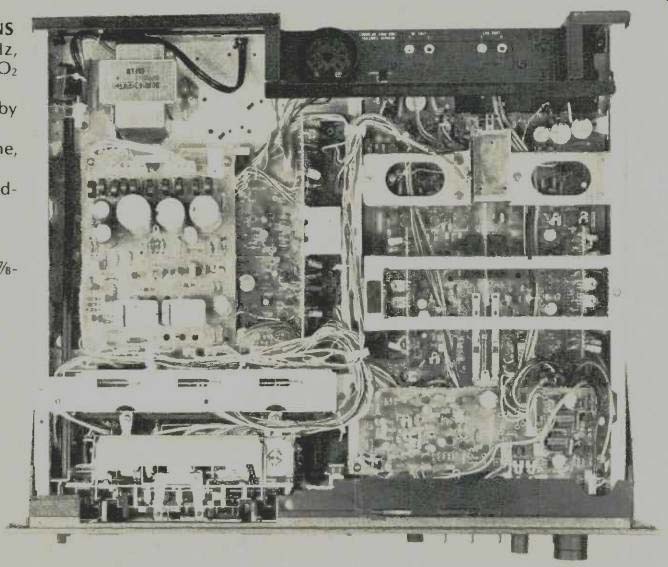
The Technics RS-M85 cassette deck delivers excellent performance in all respects for a medium-high price. The unit is made for rack-mounting, and the front panel is a standard 3 1/2-in. high. Portions of the bottom, however, project below the front panel, so some clearance would be needed from the next piece of equipment below. The deck can be placed on a table or cabinet as it is supplied with feet, but the 16-in. depth would prevent its placement on most shelves. The Eject button caused the cassette carrier and its clear cover to move out and tilt, facilitating insertion and removal of tapes.
Taking off the cover (two thumb screws) gave excellent accessibility for maintenance tasks.
Tape motion control is with light-touch, logic-controlled switches with narrow bars for actuation. Switching between modes can be accomplished in any order, except that Record cannot be added while in Play, an odd omission. There are white status indicators in the tops of the Play and Pause switch bars and a red one in Rec. Five three-position lever switches provide these selections: Bias/EQ for the three tape types, VU or peak response for the meter with a choice of higher brightness for peak, memory-on/ memory-off/timer record, off/on/on-with-filter for Dolby NR, and input selection of mike, line or Rec Mute. In the third position of the meter switch, the brightness of the fluorescent bar display can be set with a rear-panel pot. The maximum increase in brightness was not great, but there was some improvement in seeing short transients. With Timer Rec, the deck will normally start in record mode. It will start in Play if, and only if, the safety tab has been removed from the cassette. All of these spring-loaded switches snapped positively from position to position, though I prefer a record-mute switch to be momentary contact to prevent an inadvertent no-record situation. Associated with the tape selector switch is a bias adjust pot with center decent. This is an important feature, which was used to get the excellent responses reported below.
Just to the right of the counter and its reset button are the fluorescent-bar level displays. The segments cover from -20 to +8, and, as mentioned above, the responses can be set for VU or peak dynamics. The increments from one bar threshold to the next appeared to be a bit large, but this was judged to be more of a problem in testing than in actual use, as detailed later. The dual-concentric, input-level pots were somewhat difficult to adjust at times because the knobs are smooth, of the same diameter, and had slightly high friction.
The smaller diameter output level pot has the same style smooth knob with groove and red dot indices. The headphone jack is at the left end of the front panel and the microphone jacks are at the right. The gold lettering on the dark brown panel looks nice, but labels are hard to read except in good light.
Angle support brackets connect from the front rack-mounting panel to the bottom of the main chassis. On the top cover is imprinted a block diagram, curves showing the effects on response with bias adjustments, and peak and VU meter dynamic responses. The line in/out phono jacks are on the rear panel with the remote-control socket and the peak meter brightness pot. With the removal of top and side cover, several PCBs were revealed, all with excellent soldering.
All parts were identified, and adjustments were labeled and accessible. Inter-board connections were made with multi-pin cabling. The drive motors of the quartz-locked servo system were mounted within a support frame, and thus not easily examined.
Performance
Playback responses with BASF and TDK test tapes were within 2 dB at all frequencies for both EQs, and usually much closer than that. Playback of a Dolby-level tape showed that meter indications were about a dB low. Tape play speed was measured to be less than 0.1 percent fast, much closer than the great majority of decks. The tapes supplied with the deck were Maxell UD XL I, Sony FeCr, and TDK SA, and these cassettes were used for all of the detailed testing. Fast checks with pink noise and the 1/3-octave RTA showed that similar responses were possible with many tapes with the aid of the adjustable bias (See Table I).
The headroom at Dolby level (200 nWb/m at 400 Hz) was very good with the Maxell and TDK tapes, with responses to about 9 to 10 kHz. All record/playback responses were excel lent at-20 dB with very minor head-contour effects and deviations limited to t1 dB from 30 Hz to over 16 kHz. Please note that these figures are those obtained with Dolby NR. All too often, stated frequency responses are based upon the results secured without Dolby NR, and the deviations resulting when it is switched in are ignored. The plotted figures show that the Dolby tracking is superb with minor, inconsequential changes at the very highest frequencies. All of this data was run with the bias adjustment at "-3." The effect of shifting the setting to "+5" is shown on the TDK SA plot. The phase jitter in the playback of a recorded 10-kHz tone was just 20 degrees, equal to the best ever measured on a cassette deck. The 37-dB notch of the multiplex filter was centered almost exactly on 19 kHz. Bias in the output during recording was very low.
With a test frequency of 1 kHz, HDL, was measured as a function of record level with Dolby NR, as well as without NR. At the higher levels, the figures increased from Maxell UD XL I to Sony FeCr to TDK SA, but at -10 dB (re: Dolby Level) they were almost exactly the same 0.1 percent. HDL, vs. frequency was run at -10 dB with the Maxell tape with very good results overall. HDL2 was low in most cases, and HDL5 was even lower. Without NR, distortion figures were about 40 percent higher.
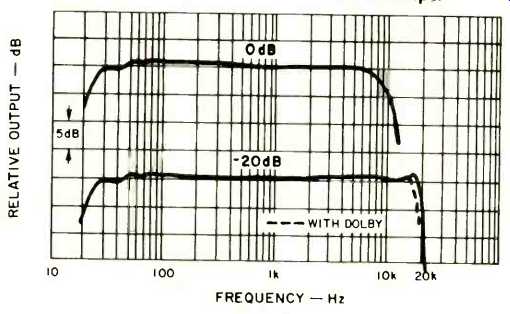
Fig 1--Frequency response with Maxell UD XL-I tape.
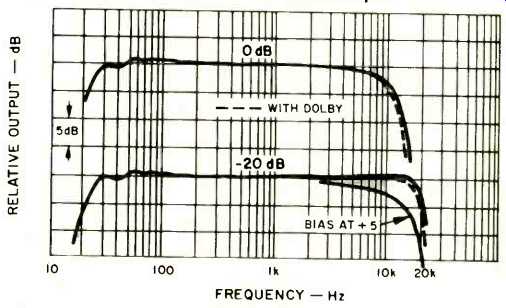
Fig. 2--Frequency response with TDK SA tape.
Table I--Record/playback responses (-3 dB limits).

Table II--Signal/noise ratios with IEC A and CCIR/ARM weightings.

The signal-to-noise ratios secured with the three tapes at Dolby level and at the HDL, 3 percent point are shown in Table II. The results are very good, and there is little to fault them even though the best figure of 65.9 dBA is lower than the specified 69 dBA. It was noted that the reduction in distortion with a "0" bias setting resulted in a smaller discrepancy, but the frequency response suffered some. Separation between tracks was a very good 46 dB, and erasure and cross talk were both down at least 80 dB, excellent figures.
Mike input sensitivity was 0.25 mV, and input overload was a high 57 mV. Line input sensitivity was 56 mV, and input dB overload clipping appeared at over 10 V, although some flattening first appeared at about 2 V. Output clipping occurred at a level equivalent to +17 dB relative to meter zero. The input level pot sections tracked within a dB from maximum down 60 dB. The line output level was 635 mV, slightly below spec. The 150-mV output at headphones to 8-ohm loads was sufficient to drive all phones tried to a high level. The output level pot sections tracked within a dB for 40 dB down from maximum.
At first look, the fluorescent level meters appear to have many segments and associated thresholds. In fact, two segments turn on at a time from -20 up to zero, and then single ones for +1, +3, +5, and +8. The thresholds were within 0.2 dB with the exception that -20 was at -23 dB, and +8 at +9.2 dB. Frequency response was from 18 Hz to 25.6 kHz.
Dynamic responses were to VU standards with that setting, and to the curves on the top cover in peak, about twice as fast as peak program meters to the British standard. In peak, the indications were just 3 dB down with 4 mS bursts. The Technics deck had the best tape-speed characteristics ever measured on a cassette deck. Earlier data had shown tape speed to be perhaps 0.07 percent fast. The flutter was only 0.025 percent W rms and just 0.045 percent Wtd Peak-superlative results. Within the limits of the instrumentation, there were no tape speed variations in playback with time or with changes in line voltage, the best ever seen. The wind times were 79 seconds. Changing wind direction or switching from wind to play required a small fraction of a second.
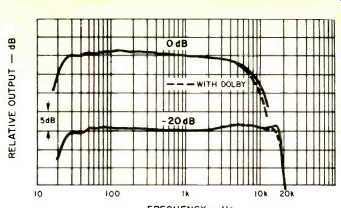
Fig. 3--Frequency response with Sony FeCr tape.

Fig. 4--Third harmonic distortion (HDL3) vs. level in the Dolby NR mode with
Maxell UD XL-I, Sony FeCr, and TDK SA tapes.
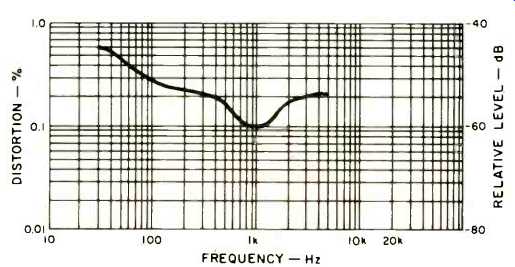
Fig. 5--HDL3 vs frequency in NR Dolby mode at 10 dB below Dolby level with
Maxell UD XL-I tape.
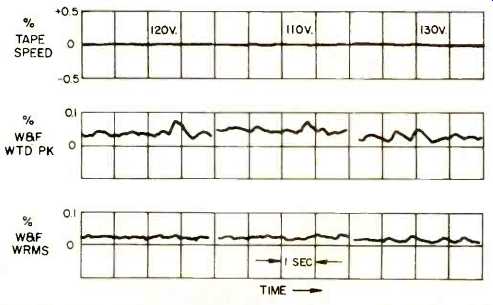
Fig. 6--Wow & flutter (three trials) and tape play speed vs. line voltage.
Listening and Use Tests
Cassette loading and unloading was smooth and easy to do. All controls and switches operated with complete reliability during the testing, which included a determined effort to defeat the tape-motion control logic. Mention was made before of lack of flying-start recording and of spring return for the record-mute switch. Levels were set very readily with the use of the meters in either VU or peak. Although there had been some question on the coarseness of the fluorescent-bar segments in earlier tests, the display was very read able with music inputs. For one thing, the intensity of a flashing segment was indicative of how far above that threshold the peak was. The 12-page instruction manual has excellent text and illustrations. The discussion on setting bias using FM interstation noise is right on the nose. There are very helpful notes and cautions in light-gray blocks, another feature of this outstanding guide for owners.
Records and FM broadcasts and interstation noise were used for the listening tests and all of the results were just fine. Was there really a slight loss in impact with Sony FeCr? One thing was certain: There was no jump in character between Dolby NR and without, and there was no need to explain drooping or peaking with Dolby, because there wasn't any. Record, pause, and stop noises were undetectable with the exception of a soft "clunk" just out of tape noise with stop. The Technics RS-M85 does not have mike/ line mixing, and it does not have a couple other things mentioned above. What this deck does have is excellent performance in every important area.
--Howard A. Roberson
=================
(Source: Audio magazine, Jun. 1979)
Also see:
Technics Model RS-99000S Cassette Deck (Jun. 1978)
Technics Model RS-616 Cassette Deck (Equip. Profile, Feb. 1979)
Sanyo Model RD5350 Stereo Cassette Deck (Feb. 1979)
Technics Model RS-1500US Stereo Open-Reel Tape Recorder (May 1977)
= = = =